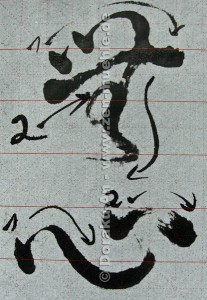Lesson 3 – MUSHIN / 無心
This is part 3 of a series with instructions for self-study of Hitsuzendo (筆禅道), a Zen-exercise with brush and ink I teach and occasionally write about in my blog. Before continuing to exercise with the below sample, you might want to read what I suggest for practising Hitsuzendo here and here.
Today’s exercise consists of two characters, 無 (MU/nothingness, emptyness) and 心 (SHIN/heart, mind, soul …). The translation of 無心 (MUSHIN) is by no means “no heart” or “heartless”, but quite the opposite. It describes an “empty” or “clear” state of mind, which is not pre-occupied by ideas or concepts or prejudices and such able to perceive and accept something new.
Students of Zen sometimes wish to achieve MUSHIN through their practise, alas, a strong desire to reach a goal scares MUSHIN away. MUSHIN is like giving up, let it go, and just focus on the next step instead of occupying the heart with desires to reach the summit.
To prepare for today’s exercise, please follow my previously posted suggestions.
The two characters can be written in one breath, or two, one for each. The lines and numbers 1-2 indicate the direction and where to start.
Some points to consider:
- write slowly, with breath-power, not with muscle force
- exhale deeply and fully while writing
- don’t rush, from start to end you might need as much as 5 seconds
- don’t accelerate towards the end to produce and artistic effect –
instead, put energy in your stroke and extend beyond the end - compare your writing to the sample: thick and thin, rhythm, balance, over-all impression
Today’s example (especially the upper character MU) is written in gyosho or cursive style, which does not much resemble it’s (more complicated) standard form.
I will post more samples later … for hands-on instructions please consider my seminars in November at Benediktushof Holzkirchen (near Wuerzburg/Germany).

Comments are closed, but trackbacks and pingbacks are open.